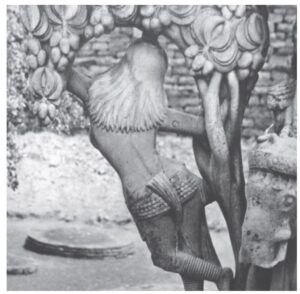Yaksinis – a brief explainer
Yakṣiṇīs appear in Brahmanical, Jain, and Buddhist texts and iconography. They inhabit lakes, rivers, forests, and in particular, trees. They are said to be beautiful, but dangerous. Humans can form relationships with them (as sisters, wives, or mothers), but they are jealous lovers, particularly if a man takes a human wife. They often feature in tantric magic as bringers of wealth, power, or secret knowledge.
The Tantrarājatantra, a compendium of magical practices describes Yakṣiṇīs as young and beautiful, wearing jewels and smeared with ointments, able to grant any desire of the practitioner who worships them in the correct manner. The Uḍḍāmareśvarātantra gives the names of 36 Yakṣiṇīs, the rituals to attract them, and the gifts that they bestow.
Here’s a selection of Yakṣiṇī names from the Uḍḍāmareśvarātantra: Surasundarī (Charming Goddess), Manohāriṇī (Heart Stealer), Kanakāvatī (Having Gold), Ratikarī (Cause of Sexual Passion), Kāmeśvarī (Lady of Desire), Naṭī (Dancer), Anurāgiṇī (Impassioned) and Padminī (Lotus Girl).
Some Yakṣiṇīs can paralyze the enemies of the practitioner; others offer magical elixirs or the secrets of alchemy, hidden treasure, or sexual delight. The rituals to appease them often take place near particular trees, or in isolated places, and the cremation ground. Some of the trees associated with Yakṣiṇīs have medicinal properties in Ayurvedic texts. Rituals to attract Yakṣiṇīs are still performed in India today.
A tale in the Kathāsaritsāraga recounts how a group of wandering ascetics spend the night in an abandoned Śaiva temple that the locals fear is haunted by a Yakṣiṇī. It is said she devours any who stray into her domain. The ascetics attempt to stave off the predations of the Yakṣiṇī by making a circle of ash and reciting mantras. But the Yakṣiṇī lures them, one by one, out of the circle and devours them, until only their leader is left. He manages to turn the Yakṣiṇī’s magic against her, and she agrees to help him in his search for his beloved.
A similar story in the Buddhist Sakuṇa-Jākata tells of an island inhabited by Yakṣiṇīs. They lure sailors to their doom (dinner) by pretending to be the shipwrecked widows of merchants; richly adorned and bearing children. They conjure an illusory city, and invite the sailors to marry them. In the story, a group of traders are rescued from the Yakṣiṇīs by a Bodhisattva in the form of a white, flying horse, with the beak of a crow.
A ferocious Yakṣiṇī is described in the Kāmaratnatantra. She is Mahābhayā (“utterly terrifying”). She wears a necklace bracelets and earrings of bone. She is to be worshipped in the cremation ground with 100,000 repetitions of her mantra using a rosary of human bone. If pleased, will bestow the secrets of alchemy, long life, and jewels. One of her mantras is given as “oṃ hrīṃ trāṃ mahābhaye klīṃ svāhā”.
There’s a good deal of overlap between the Yakṣiṇīs and the later Yoginīs.
If you want to find out more about Yakṣiṇīs, check out Yakṣiṇī Magic, by Mike Magee. Yakṣiṇī Magic is the first thorough examination of Yakṣiṇīs in Buddhist, Jain and Hindu tantric literature. With selections from previously untranslated tantric texts, Mike examines the various practices through which a tantric practitioner could propitiate these powerful, fierce and sometimes jealous female spirits. The book includes selections from eleven tantric texts in Sanskrit and Romanized Devanagari.


